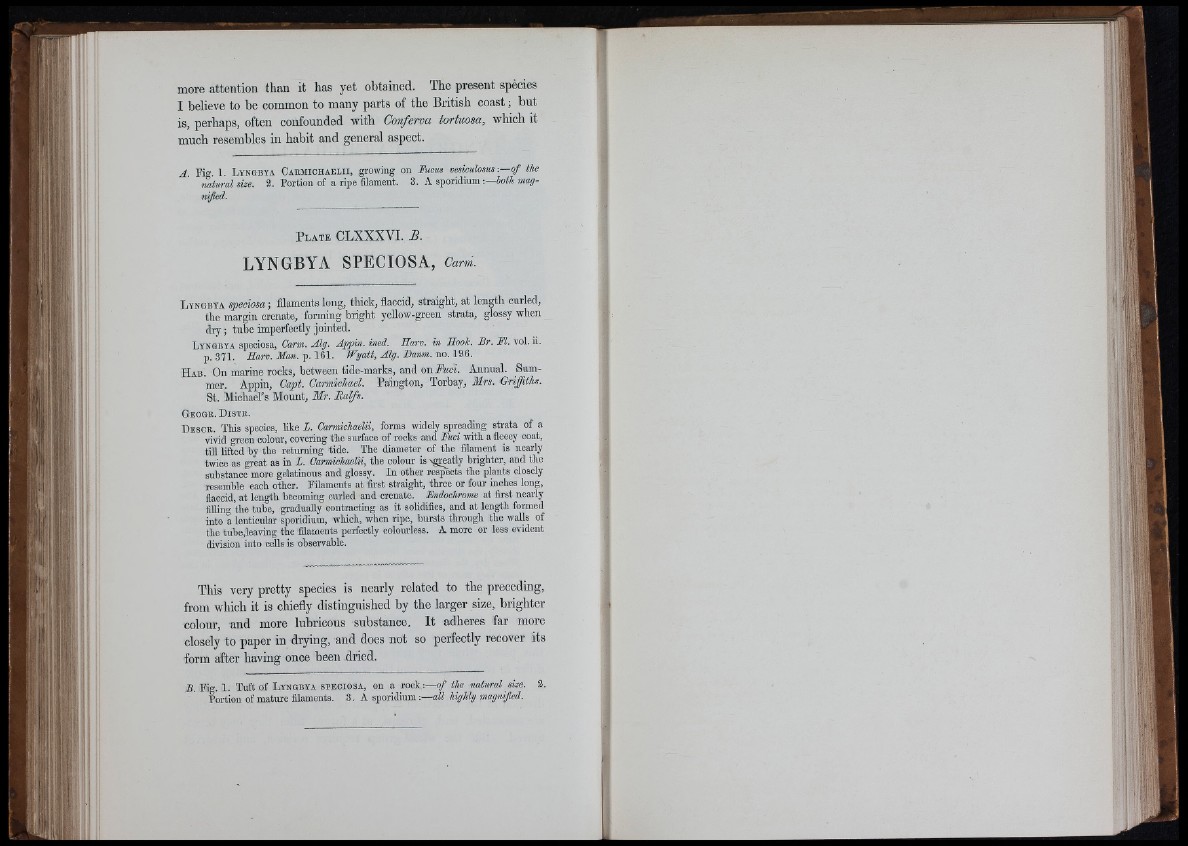
h^f!
•I, ■
I :•.
more attention than it has yet obtained. The present species
I believe to be common to many parts of the British coast; but
is, perhaps, often confounded with Conferva tortuosa, which it
much resembles in habit and general aspect.
A Fig. 1. L yngbya Ca rm ich a e l ii, growing on lucus v e s ic u lo s u s o f the
natural size. 2. Portion of a ripe filament. 3. A sporidium ■.— both mag-
nified.
4i
ii
'I'i
fti’ii
V: ■
t'i i
'■ fi' ■
P l a t e CLXXXVI. B.
LYNGBYA SPECIOSA, Carm.
L y n g b y a speciosa; filaments long, thick, flaccid, straight, at length curled,
the margin crenate, forming bright yellow-green strata, glossy when
d ry ; tube imperfectly jointed.
L yngbya speciosa, Carm. Alg. Appin. ined. Earv. in Hoolc. Br. FI. vol.u.
p. 371. Harv. Man. p. 161. Wyatt, Alg. Banm. no. 196.
H a b . On marine rocks, between tide-marks, and on Fuci. Annual. Summer.
Appin, Capt. Carmichael. Paington, Torbay, Mrs. Griffiths.
St. Michael’s Mount, Mr. R a lfs.
Geogr. D is t r .
D e sc r . This species, like L. Carmichaelii, forms widely spreading strata of a
vivid green colour, covering the surface of rocks and Fuci with a fleecy coat,
tm lifted by the returning tide. The diameter of the filament is nearly
twice as gi-eat as in L. Carmichaelii, the colour isNgreatly brighter, and the
substance more gelatinous and glossy. In other respects the plants closely
resemble each other. Filaments at first straight, three or four inches long,
flaccid, at length becoming curled and crenate. Endochrome at first nearly
filling the tube, gradually contracting as it solidifies, and at length formed
into a lenticular sporidium, which, when ripe, bursts through the walls of
the tube,leaving the filaments perfectly colourless. A more or less evident
division into ceUs is observable.
This very pretty species is nearly related to the preceding,
from which it is chiefly distinguished by the larger size, brighter
colour, and more lubricous substance. It adheres far more
closely to paper in drying, and does not so perfectly recover its
form after having once been dried.
B . Fig. 1. Tuft of L yngbya s pec iosa, on a ro ck ;— of the natural size. a.
P o r t i o n of mature filaments. 3. k iponXmm:— all highly magnijied.
II fl-E
t'l